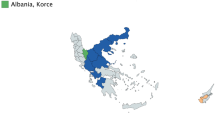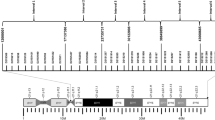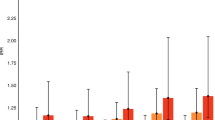Abstract
Parental ages associated with both maternal and paternal uniparental disomy (UPD) of chromosome 15 are highly elevated in comparison to Zurich population-based controls, with mean maternal and paternal ages of 35.6 and 38.1, respectively for UPD patients (diagnosed in Zurich) and 28.0 and 31.0, in controls. The parental ages are also significantly higher than observed for trisomies of other chromosomes diagnosed in Zurich. The higher age of UPD cases may be due to the fact that two errors, both a gain and a loss of a chromosome 15, are necessary. We suggest that gamete complementation, zygote formation from two gametes one of which is nullisomic and the other disomic for the same chromosome, may be a major mechanism of UPD formation, as well as secondary loss of a chromosome in a trisomic conception, and that there is an association between increased paternal age and nondisjunction.
Similar content being viewed by others
Introduction
The occurrence of uniparental disomy (UPD) requires two nondisjunction events, which may be either meiotic or mitotic, resulting in a gain of a chromosome from 1 parent and loss of the homologous chromosome from the other parent. Maternal UPD of chromosome 15 is found in about 25% of Prader-Willi syndrome (PWS) patients [1–3] and paternal UPD(15) is found occasionally in Angelman syndrome (AS) patients [4–6]. In these reported cases, uniparental inheritance was always observed for the entire chromosome 15.
An association between increased maternal age and nondisjunction is well known, however the relative lack of paternally derived trisomy cases has made a risk of paternal age and nondisjunction difficult to test. Another difficulty in studying parental age effects is that the expected mean parental age in a population is strongly culturally dependent and will vary between geographic regions, economic classes, and through time and makes comparison of data between centers difficult.
We present data on parental ages for maternal and paternal UPD(15) patients. These ages are compared to those for trisomies of chromosomes 18 and 21, and XXY individuals where molecular studies have been performed and where patients have been ascertained or diagnosed through the Institute of Medial Genetics at the University of Zurich. control data was obtained by examining parental ages from children admitted to the Children’s Hospital in Zurich for appendectomy operations between the years of 1985 and 1990 and from data between 1971 and 1989 on maternal age for all births registered in Switzerland.
Methods
Ascertainment of patients was mostly through routine referrals for genetic diagnosis. UPD(15) cases were ascertained through molecular studies of PWS and AS patients. Some of the cases analyzed in Zurich originated from Northern Italy and West Germany. We also separately report the parental ages for 4 paternal UPD(15) cases ascertained at the University of London (UK), and maternal UPD(15) cases diagnosed in Vancouver (Canada), Munich (FRG), and Essen (FRG).
Molecular studies on all of these patients, except those from Essen and Munich, have been reported elsewhere [2, 4, 7–10]. Molecular diagnosis of trisomy 21 patients were performed in the laboratory of Prof. S. Antonarakis (Baltimore, Md., USA). All other molecular data on Zurich patients were obtained in Zurich. Additional patients with XXY and trisomy 18 have been analyzed using molecular techniques as previously published [9, 10].
Control parental ages were obtained by examining the age of parents at birth of 125 appendectomy patients admitted to the Children’s Hospital in Zurich between 1985 and 1990. The mean birth year, 1983, of the control patients was the same as for the UPD(15) patients. In addition, data available from the Swiss Federal statistics office (Bundesamt für Statistik, Sektion Bevölkerungsentwicklung) on maternal ages in Switzerland show a mean maternal age of 28.1 in 1983 based on 73,659 live births. The mean maternal age over time has increased slightly with a mean age of 27.5 (n = 96,261) in 1971 and a mean of 28.9 (n = 81,180) in 1989. Matched control parental ages for the London sample were taken from 20 AS patients diagnosed with either a deletion of 15q11–q13 or normal chromosomes 15.
Meiotic stage of origin in UPD(15) cases was determined by the state of the most proximal informative marker to the centromere (usually D15S11) [6, 8]. Nonreduction of the parent-of-origin heterozygosity for proximal markers in the patient is evidence in favor of an MII nondisjunction event and reduction is compatible with an MII or a mitotic event. When reduction to homozygosity was seen for all markers along chromosome 15, the extra chromosome was inferred to have arisen by a mitotic nondisjunction event. Detailed molecular data and a determination of molecular origin has been presented on most of these patients in reference [8], with the exception of AS2 [4] and AS4884 [6].
Results
In order to illustrate the extent to which populations may differ in mean parental age, we have compared data from PWS patients from our own studies [2, and unpubl. data] to that from a study in the United States [3] (table 1). All typical PWS patients are found to have either a deletion inherited on the paternal chromosome 15 or maternal UPD(15). The latter is associated with increased parental ages, however deletion cases seem to reflect the population mean and are not associated with significantly altered parental ages. Although in both studies the increased age associated with UPD(15) is significant, the Zurich parents are significantly older for all categories. Mixture of the two data sets could result in lower significance than either data set considered separately, due to the increase in heterogeneity within each category.
The mean parental ages of deletion PWS patients are very similar to the ‘Zurich’ control data collected from appendectomy patients (table 2) and to published figures of maternal age for all births in Switzerland (mean maternal age of 28.1 in 1983). The control ages for the Zurich population are also higher than observed in the London sample (mean maternal and paternal ages of 26.5 and 28.6, respectively).
Comparison of parental ages in aneuploid patients ascertained in Zurich and investigated by molecular methods shows an increase in parental age relative to controls for all classes (table 2). When considering only those cases shown by molecular studies to be maternally derived, the results are virtually identical to considering the group as a whole (data not shown). The sample sizes are quite small for cases where the extra chromosome has been shown to be paternally derived, however, in all cases the paternal ages are greater than the mean. This increase is statistically significant in the trisomy 18 (p < 0.05), XXY (p < 0.05) and paternal UPD15 group (p < 0.0005) (table 3). An increase in paternal age is also seen for 4 cases of paternal UPD(15) diagnosed in London with means of 30.2 and 34.5 for these cases compared to mean maternal and paternal ages of 26.5 and 28.6 respectively, in the London control sample (table 4).
The mean parental ages in UPD(15) patients are not only very significantly increased over controls, but are higher than for parents in all other hyperdiploid classes. This increase is statistically significant when compared to the trisomy 21 and XXY sample (p < 0.05 for both mothers and fathers, Student’s t test) and comparison to the trisomy 18 sample (p < 0.05 for comparison between mothers and p < 0.1 for fathers). The increase in parental ages is observed for both maternal and paternal UPD(15).
Parental ages by origin of nondisjunction are given in table 5, however, due to small sample sizes and heterogeneity in sources of the patients, statistical comparisons were not done. A younger mean age is observed for the maternal mitotic cases compared to those of meiotic origin, however, the extremely low maternal and paternal ages (19 and 21) in one family largely influence the mean.
In both the Zurich and London paternal UPD(15) cases, there is a greater increase in paternal than maternal ages. Relative to the appropriate population means, the maternal age is on average increased 5 years above the population mean, whereas the paternal ages are on average 9 years greater than the population mean. This is surprising since all but one of the paternal UPD(15) cases are consistent with a mitotic origin of the extra chromosome, i.e. reduction of paternal heterozygosity to homozygosity was seen for polymorphic markers throughout the chromosome 15. The mean age of fathers in paternal UPD(15) mitotic cases is also higher than in the fathers of maternal UPD(15) mitotic cases, but the patients were also mostly ascertained from different populations.
Discussion
The data presented here show a strong association between increased parental age and the occurrence of both maternal and paternal UPD(15). The mean parental ages for our UPD(15) cases are even higher than is normally observed for trisomies of other chromosomes. This does not seem to be due to ascertainment since the PWS deletion parents have very similar ages to, and even slightly less than, the control sample. Although we have no data on parental ages of trisomy 15 in Switzerland, previous reports indicate that age effects are strongest for the smallest chromosomes (i.e. chromosome 21) and that the age-dependent curve for trisomy 15 is of a similar shape as that for trisomy 21 [11–13]. The significant increase in parental ages in the UPD(15) cases as compared to trisomies [18, 21 and XXY, indicates that the loss of the nontransmitting parent’s chromosome may also be associated with an age effect. Although the increase in parental ages is less for those cases where the duplicated maternal chromosome is due to a presumed mitotic event, the majority of such cases were ascertained at centers where we have no control population data and the relative age is therefore difficult to evalaute.
Although there is evidence that some maternal UPD(15) cases arise as a trisomic fertilization with subsequent loss of the paternal chromosome [14, 15], it is also likely that a proportion of UPD cases originate from gamete complementation as hypothesized by Engel [16]. The frequency of aneuploidy in human oocytes is estimated as 18–19% and in spermatocytes is 3–4%, with an excess of D group chromosome aneuploidy in oocytes [17]. These rates can easily account for the observed frequencies of maternal and paternal UPD(15). Although the extent to which in vitro studies of human gametes represent what actually participates in fertilization is unknown, it is probable that both gamete complementation and loss in a trisomic fertilization are frequent mechanisms leading to UPD(15).
Although gamete complementation would be compatible with the unusually high parental ages in maternal UPD(15), the increase in paternal ages associated with paternal UPD(15) is somewhat of an enigma. All the fathers in the Zurich cases were over 40 years of age (p < 0.0005), however 2 of the mothers were more than 10 years younger, hinting that the increased ages in paternal UPD are not simply due to correlation with an increased maternal age, as might potentially be associated with hypohaploidy of the oocyte. A similar observation is seen in 3 of the 4 London cases, where the increase in paternal age is greater than the increase in maternal age. This observation is especially surprising since all but one of the paternal disomy cases are likely to have a mitotic origin of the extra paternal 15. This raises the possibility that chromosomes from older males may be more prone to early post-zygotic nondisjunction. It is also conceivable that these presumed mitotic errors, may in fact be meiotic in origin, resulting from absent recombination in meiosis I followed by a meiotic II nondisjunction event. Although this seems implausible, recombination and meiotic I and II nondisjunction may both be correlated with the same factors; for example, if premature centromere division occurs leaving unpaired sister chromatids. Another possibility is if the spermatocyte undergoing meiosis carries only one chromosome 15 due to a premeiotic loss (which could increase in older males due to an increased number of cell divisions prior to spermatogenesis), then normal pairing and recombination at meiosis I could not occur and might result in a hyperhaploid spermatocyte with two identical chromosomes 15.
It is of interest that we also observe evidence for increased paternal age in other paternally derived trisomy cases examined at our institute in Zurich. Since nondisjunction may be due to both age-dependent and age-independent factors, sampling from a population with a high mean parental age will result in a greater proportion of aneuploidies due to age-dependent effects than would be sampled in a relatively young population and would maximize the probability of detecting an age effect if one exists. As estimated from the paternal age of deletion PWS patients (see table 1), the mean age of fathers in Switzerland (and the bordering areas of Northerm Italy and West Germany) is 4–5 years greater than that of the United States. Such a difference has the potential to have a large effect if, as is seen in women, the rate of nondisjunction increases exponentially with age at the higher range of breeding ages. The higher mean age of parents in Switzerland also explains our relatively high observed rate of UPD(15) cases among PWS and AS patients (approximately 30 and 18%, respectively).
In summary, an increase in parental ages is observed for both maternal and paternal UPD(15) and this increase is greater than seen for other trisomies. This raises the possibility that gamete complementation, and not only trisomy followed by post-zygotic chromosome loss, may be a major mechanism in uniparental disomy formation, and that there is a paternal age effect associated with nondisjunction (either meiotic or mitotic) of chromosome 15.
References
Nicholls RD, Knoll JHM, Butler MG, Karam S, LaLande M: Genetic imprinting suggested by maternal heterodisomy in non-deletion Prader-Willi syndrome. Nature 1989;342:281–285
Robinson WP, Bottani A, Yagang X, Balakrishnan J, Binkert F, Mächler M, Prader A, Schinzel A: Molecular, cytogenetic, and clinical investigations of Prader-Willi syndrome patients. Am J Hum Genet 1991;49:1219–1234
Mascari MJ, Gottlieb W, Rogan PK, Butler MG, Waller DA, Armour JAL, Jeffreys AJ, Ladda RL, Nicholls RD: The frequency of uniparental disomy in Prader-Willi syndrome. N Engl J Med 1992;326:1599–1607
Malcolm S, Clayton-Smith J, Nichols M, Tobb S, Webb T, Armour JAL, Jeffreys AJ, Pembrey ME: Uniparental disomy in the Angelman syndrome. Lancet 1991;337:694–697
Nicholls, RD, Pai GS, Gottlieb W, Cantu ES: Paternal uniparental disomy of chromosome 15 in a child with Angelman syndrome. Ann Neurol 1992;32:512–518
Mutirangura A, Greenberg F, Butler MG, Malcolm S, Nicholls RD, Chakravarti A, Ledbetter DH: Multiplex PCR of three dinucleotide repeats in the Prader-Willi/Angelman critical region (15q11–q13): Molecular diagnosis and mechanism of uniparental disomy. Hum Mol Genet 1993;2:143–151
Antonarakis SE, Avramopoulos D, Bloum JL, Talbot CC, Schinzel AA: Mitotic (somatic cell) errors cause trisomy 21 in about 4.5% of cases and are not associated with advanced maternal age. Nature Genet 1993;3:146–150
Robinson WP, Bernasconi F, Mutirangura A, Ledbetter DH, Langlois S, Malcolm S, Morris M, Schinzel AA: Nondisjunction of chromosome 15: Origin and recombination. Am J Hum Genet 1993;53:740–751
Lorda-Sanchez I, Binkert F, Maechler M, Robinson WP, Schinzel AA: Reduced recombination and paternal age effect in Klinefelter syndrome. Hum Genet 1992;89:524–530
Ya-gang X, Robinson WP, Spiegel R, Binkert F, Ruefenacht U, Schinzel AA: Parental origin of the extra chromosome in trisomy 18. Clin Genet 1993;44:57–61
Hassold TJ, Jacobs PA: Trisomy in man. Annu Rev Genet 1984;18:69–97
Risch N, Stein Z, Kline J, Warburton D: The relationship between maternal age and chromosome size in autosomal trisomies. Am J Hum Genet 1986;39:66–78
Hassold TJ, Chiu D: Maternal age-specific rates of numerical chromosomal abnormalities with special reference to trisomy. Hum Genet 1985;70:11–17
Purvis-Smith SG, Saville T, Manass S, Yip M-Y, Lam-Po-Tang PRL, Duffy B, Johnston H, Leigh D, McDonald B: Uniparental disomy 15 resulting from ‘correction’ of an initial trisomy 15. Am J Hum Genet 1992;50:1348–1350
Cassidy SB, Lai Li-Wen, Erickson RP, Magnuson L, Thomas E, Gendron Herrmann J: Trisomy 15 with loss of the paternal 15 as a cause of Prader-Willi syndrome due to maternal disomy. Am J Hum Genet 1992;51:701–708
Engel E: A new genetic concept: Uniparental disomy and its potential effect, isodisomy. Am J Med Genet 1980;6:137–143
Martin RH, Ko E, Rademaker A: Distribution of aneuploidy in human gametes: Comparison between human sperm and oocytes. Am J Med Genet 1991;39:321–331
Acknowledgements
This project was supported in part by the EMDO Stiftung, Zurich and Swiss National Foundation grant B 2006.295.3412 (W.P.R. and A.S.); work in S.M. lab was generously funded by Action Research and the Medical Research Council UK. We thank Dr. G. Gillessen-Kaesbach and Prof. E. Passarge for clinical evaluation of the Essen patients.
Author information
Authors and Affiliations
Rights and permissions
About this article
Cite this article
Robinson, W.P., Lorda-Sanchez, I., Malcolm, S. et al. Increased Parental Ages and Uniparental Disomy 15: A Paternal Age Effect?. Eur J Hum Genet 1, 280–286 (1993). https://doi.org/10.1159/000472425
Received:
Revised:
Accepted:
Issue Date:
DOI: https://doi.org/10.1159/000472425
Key Words
This article is cited by
-
Advanced parental age in maternal uniparental disomy (UPD): implications for the mechanism of formation
European Journal of Human Genetics (2004)
-
Linear increase of diploidy in human sperm with age: A four-colour FISH study
European Journal of Human Genetics (2001)
-
Genotype-phenotype correlation in a series of 167 deletion and non-deletion patients with Prader-Willi syndrome
Human Genetics (1995)
-
Phenotype of the Williams-Beuren syndrome associated with hemizygosity at the elastin locus
European Journal of Pediatrics (1995)



